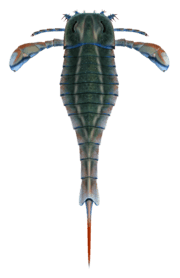Eocarcinosoma
| Eocarcinosoma | |
|---|---|
| Scientific classification | |
| Kingdom: | Animalia |
| Phylum: | Arthropoda |
| Subphylum: | Chelicerata |
| Order: | †Eurypterida |
| Superfamily: | †Carcinosomatoidea |
| Family: | †Carcinosomatidae |
| Genus: | †Eocarcinosoma Caster & Kjellesvig-Waering, 1964 |
| Type species | |
| †Eocarcinosoma batrachophthalmus Caster & Kjellesvig-Waering, 1964 | |
Eocarcinosoma is a genus of eurypterid, an extinct group of aquatic arthropods. Fossils of Eocarcinosoma have been discovered in deposits of the Ordovician age in the United States. The genus contains one only species, E. batrachophthalmus, from the Ashgillian age of Ohio.[1]
It is classified as part of Carcinosomatidae, an eurypterid family classified as part of the superfamily Carcinosomatoidea. With the biggest specimen measuring 3 centimetres (1.2 inches) in length, Eocarcinosoma is one of the smallest eurypterids that have existed.
Description
Eocarcinosoma was a small sized eurypterid at 3 cm (1.2 in), being easily overtaken by other carcinosomatids such as Eusarcana scorpionis at 80 cm (31.5 in) or Carcinosoma punctatum, one of the largest eurypterids with 2.2 meters (7.2 feet). This makes it the smallest eurypterid along with the more basal onychopterellid Alkenopterus burglahrensis.[2]
Eocarcinosoma is based in one only well-preserved carapace (head plate). The prosoma ("head") was broad and subtriangular (somewhat triangular), with rounded frontal margins bent downward, what probably served to excavate in the mud. The lateral compound eyes were placed marginally (in the margins), prominent and roughly reniform (bean-shaped). The ocelli (light-sensitive simple eyes) occupied a central position, slightly behind the eyes, and were on a small, rounded and ocellar mound.[3]
See also
References
- ↑ Dunlop, J. A., Penney, D. & Jekel, D. 2015. A summary list of fossil spiders and their relatives. In World Spider Catalog. Natural History Museum Bern, online at http://wsc.nmbe.ch, version 18.5 http://www.wsc.nmbe.ch/resources/fossils/Fossils18.5.pdf (PDF).
- ↑ Lamsdell, James C.; Braddy, Simon J. (2009-10-14). "Cope's Rule and Romer's theory: patterns of diversity and gigantism in eurypterids and Palaeozoic vertebrates". Biology Letters: rsbl20090700. doi:10.1098/rsbl.2009.0700. ISSN 1744-9561. PMID 19828493. Supplementary information
- ↑ Caster, Kenneth E.; Kjellesvig-Waering, Erik N. (1964). Upper Ordovician eurypterids of Ohio. Paleontological Research Institution.
